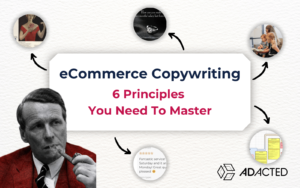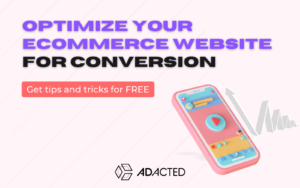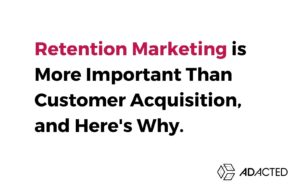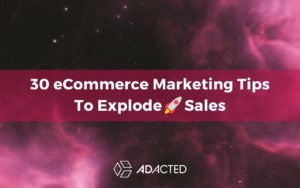eCommerce marketing has blown up lately and if you’re still out of the loop on it, don’t worry, we’re here to help you.

1. First of all, what is eCommerce marketing?
eCommerce marketing is simply marketing for an eCommerce site.
That’s all there really is to it.
To understand it more fully, we must make sure we understand the definition of both eCommerce and marketing.
eCommerce
Also known as electronic commerce or internet commerce, refers to the buying and selling of goods or services using the internet, and the transfer of money and data to execute these transactions. It is often used to refer to the sale of physical products online, but it can also describe any kind of commercial transaction that is facilitated through the internet such as selling digital products, services, or courses.
Marketing
That’s a big word and you probably already know what it means, but I’ll give you a quick brief: Google defines it as “the action or business of promoting and selling products or services, including market research and advertising.”
Or as The New York Times described it in 2017 – “the art of telling stories so enthralling that people lose track of their wallets”.
| If you’re a bit confused as to what is the difference between digital marketing and eCommerce marketing, I’ll try to clear it up. eCommerce literally means just regular commerce gone online – instead of brick and mortar shops you have an online store. eCommerce marketing is just marketing for these stores. Digital marketing is just regular marketing gone digital. Hence, the word digital. In other words, eCommerce stores can use digital and traditional marketing platforms, and digital marketing can also be done for brick-and-mortar stores. |
eCommerce Marketing Strategy as a Funnel
The process of marketing itself is very wide-ranging and it is difficult to summarize it, but for starters, you could think of it as a funnel that is commonly divided into three parts:
- Creating awareness / increasing traffic / generating leads
- Converting them to paying customers
- Retaining those customers for future purchases
Creating awareness / Increasing traffic / Generating leads
In other words, making your eCommerce site known to your target audience and educating the larger public so they could also get interested in your product.
For example, promoting your brand on social media platforms, the radio, in newspapers, etc. Your purpose would be to make yourself known and appeal to those customers who need your product.
Converting them into paying customers
This conversion phase is the most important part of your eCommerce marketing strategy. That’s because it is in this stage that you convert people who are interested in your product into paying customers.
There are many different ways to do so and not all marketing strategies work for everyone. The fact is, every business has a unique target audience with different needs and wants.
For example, some businesses might be focused on getting large orders while others seek smaller purchases from their clients. You must take into account what works best for your company before deciding which methods to use in order to make the most out of this step of the funnel process – converting them into paying customers.
Retaining those customers for future purchases
This is where the magic occurs – this phase can have the biggest bang for your buck, because it is essentially organic marketing. If your product is excellent, they’ll recommend it to others and might even buy something else from you.
To succeed in eCommerce marketing, all three of these steps must be executed well.
Another way is to divide marketing into two parts, the front end, and the back end.
Front end – everything related to getting new clients to spend money. Such as Advertising, lead generation, email marketing, etc.
Back end – everything that has to do with what happens after a customer purchases something, such as delivering a great service/product, upselling, referrals, etc.
This picture gives you a nice overview of this:
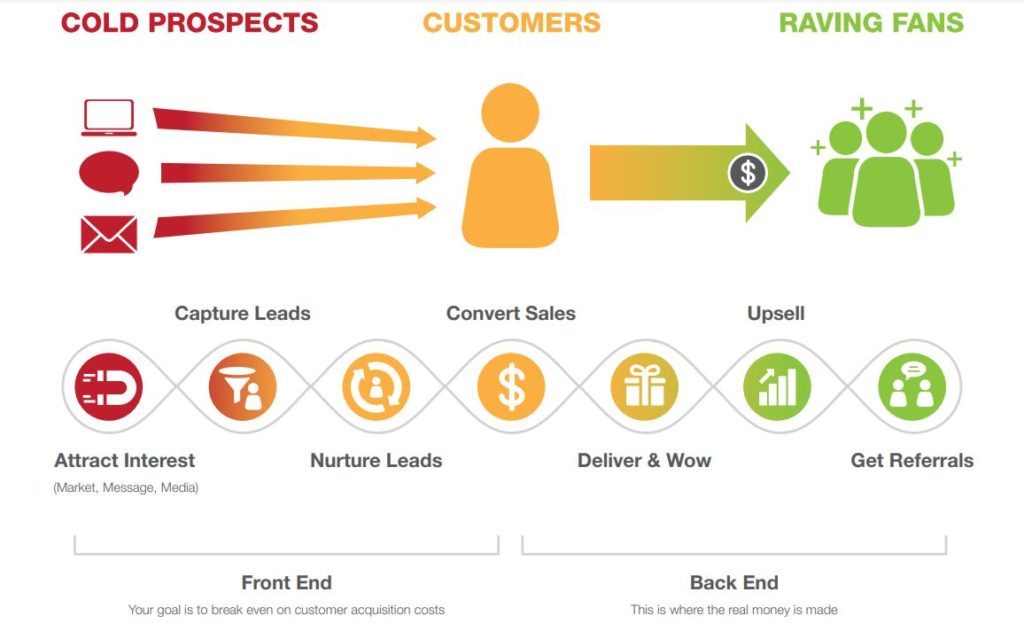
© Credit 1 Page Marketing Plan
That was a brief overview of eCommerce marketing. Now we’ll go more in-depth with the above-mentioned subcategories of marketing and how to apply them when doing marketing for eCommerce.
2. The e Commerce Marketing Funnel

Now that we have an overview of eCommerce marketing and the marketing funnel, the next question would be how to actually apply all this knowledge. First of all, let’s have a look at it from the customer’s perspective.
What exactly goes on in the customer’s head from once he’s aware of a need/problem to solve to purchasing something? Let’s look at the buyer’s decision process.

Understanding the buyer’s online shopping decision process
This process was first introduced by John Dewey in 1910, and it consists of 5 stages:
1. Problem/Need Recognition
In this stage, the customer recognizes what the problem or need is and identifies the product or type of product that is required to solve it. There are different problems and needs, ones that have clear solutions and others that are a bit vaguer.
For example, when you get a flat tire on your way to work on a bicycle, and you’re out of spare inner tubes, the problem and the solution are very clear. The inner tube is broken – > either buy a new one or fix the current one, simple.
But if you’re unsatisfied with your marriage, there really isn’t a simple solution. You might need counseling, maybe some rekindling, or maybe it just isn’t a good fit, and you found out too late.
2. Information Search
The consumer will search for possible solutions to this problem, either turning to google, browsing different forums, Facebook groups, or asking someone they trust.
Following the previous examples, for the inner tube incident, one would probably search for the nearest bicycle store or if not in a hurry, search for some bulk offers online.
In the failing marriage example, you might start by asking for advice from your parents, or discussing it with a close friend, looking for marriage counselors, maybe a weekend getaway, or even divorce lawyers, and the list doesn’t stop there.
3. Evaluation of Alternatives
The consumer evaluates the searched alternatives. Generally, the information search reveals multiple products or services for the consumer to evaluate and understand which of those would be appropriate.
This evaluation stage usually follows the information search or is happening concurrently with it. Once again, the length of this stage depends on the problem itself. It’s pretty easy to evaluate the differences in buying a new inner tube for your bicycle. For other problems, such as the failing marriage example, this might take a bit longer.
4. Purchase Decision
After the consumer has evaluated all the options and wants to buy the product or service. Before actually buying the product, the customer needs to feel safe with the purchase. Negative reviews or lack of any social proof might make it difficult.
5. Post Purchase Behavior
After the purchase, the consumer may either be pleased with the purchase or experience post-purchase dissonance. Addressing this post-purchase dissonance spreads the word for the product and increases the chance of getting repeat purchases.
Applying the Marketing Funnel
Now that we understand the client’s journey from being unaware of the problem to becoming a client, we can have a look at how does this affects us as eCommerce marketers and what we should learn from this.
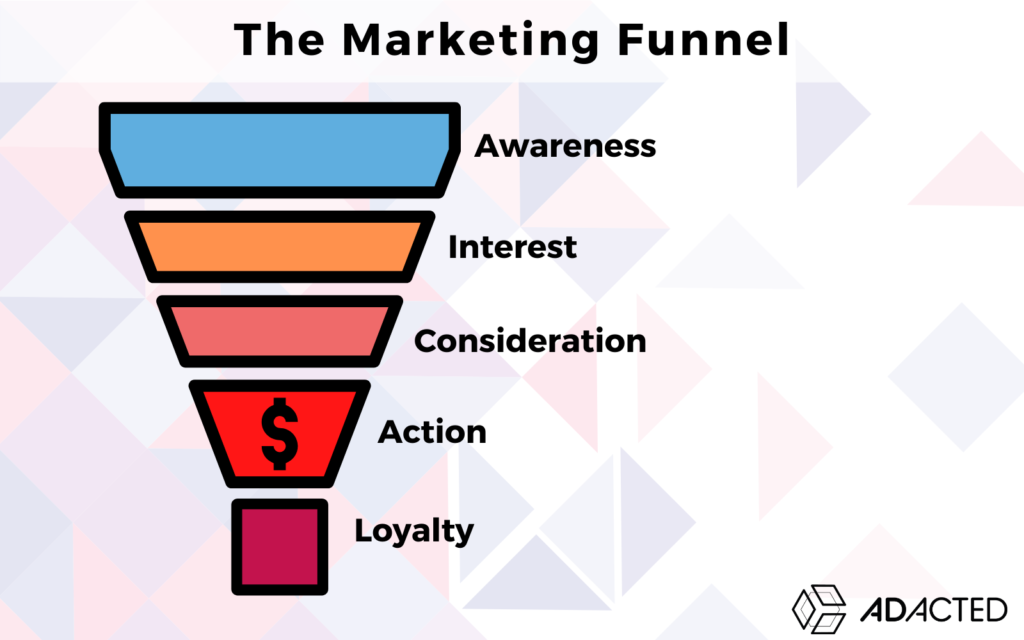
The widest tier at the top of the funnel represents “awareness,” the point at which potential customers either become aware or are informed about the problem. The second tier is “interest,” roughly corresponding to the information search stage. “Consideration” and “action” are self-explanatory. And, finally, loyalty – everything that happens post-purchase.
PS! The funnel is just one part of your larger strategy. Before building a marketing funnel for your eCommerce brand you should create an overall marketing plan. If you want to maximize your potential you have to have a plan in place.
“A failure to plan is a plan to fail.”
– Benjamin Franklin.

Back to the topic at hand, how does one create a marketing funnel?
First of all, you need to figure out:
- How will customers at any given stage find me?
- What kind of information do I need to provide to help them move from one stage to the next?
- How will I know if they have converted or moved from one stage to another?
1. Problem/Need Recognition stage – Top of Funnel
The prospects in this stage are a part of the cold audience, as they are still only either aware or unaware of their problem/need, not actively seeking information.
There are two ways to approach this, you could either target the audience who is aware of their problem and in need of a solution, or you could try and create the need. For example, reminding them of a problem or educating them about one they were not familiar with.
The first is certainly more effective and cheaper, also a bit more ethical, as we’re not influencing people to buy something that they don’t really need.
Continuing with the inner tube problem, let’s say we own an eCommerce store that sells bicycle equipment. We know that cyclists need inner tubes, so there’s no need to further that need in them, right? We could skip this step and focus on the next stage, right?
No.
There’s still a group of cyclists who may have forgotten that they’re running on their last spare. Or even people new to cycling who may have never changed an inner tube themselves. Even more, some people don’t even own a bike yet but maybe would like to.
These are still viable customers. Even though they’re harder to reach (read: more expensive), we should not forget about them, as there are some very efficient low-cost ways to approach this without spending a fortune on “Brand Awareness” marketing strategies. More on this here.
Here are some platforms and tools you can make noise with for the first stage, aka the Cold Audience aka Top of Funnel:
Digital marketing:
Social Media (Instagram, Facebook, etc.), Blog posts, Paid Advertising, Influencer Marketing, Infographics, Videos, Podcasts, Generic Social Media updates/content, Search Engine Optimization, Affiliate marketing.
Traditional media:
TV, Radio, Newspapers, Magazines, Local Marketing, etc.
You might be thinking “what, traditional media for an eCommerce store?!” – hear me out. It all depends on who your customers are and where they spend their time. You have to understand that even with all the possibilities of digital marketing nowadays, we shouldn’t forget traditional media.
If let’s say you own an eCommerce store focused on Hobby and Craft, you might realize that a lot of your potential customers are actually 60+ people who still read the newspaper. And a lot of people still listen to the radio on their commute. These could be great channels to reach your target market.
The key point here is to identify exactly where your customers spend their time. Most often than not though you will be focused more on digital marketing channels, because they are more trackable and usually a bit cheaper.
An Example of how to build Top-of-Funnel Facebook ads
Audience:
If we’re on a tight budget our actual ads in this stage shouldn’t be targeted at people who have nothing to do with cycling. Our aim should be to find an audience that regularly uses bikes.
Message:
We could try some different angles here:
- For people who’ve never changed a tire before, we could create an ad showing how to change one and how they can save a lot of money doing it themselves.
(Ex: Paid ads or regular content containing a video or an infographic)
- For bike commuters, we could do a simple reminder sort of an ad or post. “I hope you’re not running on your last spare, if so, you’re in luck, we’re offering 3 innertubes for the price of 2 until the end of this week”, or something similar.
(Ex: Paid Ads, regular content, Influencer outreach, etc)
- Or just offering valuable content/information for any audience, who might be interested.
(Ex: Videos, blog posts, Podcasts etc.)
The content of ads targeted to cold audiences should be attention-grabbing, educational, and offer high value. For example, titles like “Did you know that…”, “The 3 best ways to..”, etc.
The key point here is actually offering them something valuable for their time spent reading and engaging with the ad.
Key takeaways for Top-of-Funnel eCommerce marketing:
Your top-of-the-funnel campaigns should have content that’s focused on awareness, just like any other organic post. Focus top-of-the-funnel campaigns on post engagement and promoted posts for content specifically geared toward your Facebook audience. Leave your ad campaigns for farther down the funnel to focus on conversions.
2. Information search – Middle of Funnel
As we know prospects in this stage are aware of their problem and they are actively searching for a solution. We could call them a warm audience, as they are more likely to convert than someone who isn’t aware of their problem.
Some questions that you need to ask yourself in this stage:
- Where are my prospective customers actively looking for information?
During this stage, we should target channels where they are actively searching for information. Our purpose would be to give them the valuable info they are looking for or at least offer to give them the answer after an email submission, for example – it depends on your marketing goals.
As people who are searching for a solution rarely go see the newspapers, television, or radio, we can set aside the traditional media outlets at this point and focus on the digital channels people do turn to in search of answers, such as:
Search engines like Google Ads, Youtube, Bing (still used in a lot of countries), and Baidu (nr 1. search engine in China).
(You need to figure out what is popular in your market, it’s most probably Google as it has a 92% market share globally)
Or forums like Reddit and Quora, and also Facebook groups.
Search engines
Our goal here would be to rank up high on search engine results pages when someone searches for our product or questions regarding our niche. There are two tools we can use here.
Content Marketing and Search Engine Optimization
You can create content and optimize your online store for informational target keywords to get better rankings and capture more ‘middle of the funnel’ traffic. In the same way, you can educate your viewers with social media marketing, host webinars, and get guest posts on industry websites that give their viewers unbiased information.
PPC (Pay-Per-Click) Ads
This is essentially paid search engine optimization – you pay for your spot on the top of the search engine.
The way this works is that you bid for ad placement in a search engine’s sponsored spot when someone searches on a keyword that is related to their business offering. For example, if you bid on the keyword “Bicycle innertube” your ad might show up at the top of the results page of the search engine. Just make sure you do proper keyword research before putting any ad spend on the table.
Forums and Community
These are often overlooked sources of leads and potential customers. If you have a specific niche with your eCommerce website, you should be visible not only on Google and social media but also actively engaging with the community of that niche on different forums and Facebook groups. Answering questions, sharing valuable content, and helping the community out will make you the authority figure and the expert in your industry. This marketing strategy is one of the cheapest (but time-consuming) to attract new customers and build a loyal customer base.
Another marketing strategy is advertising on these forums like Quora and Reddit, or you could target the members of specific facebook groups with ads.
- What kind of information do customers search for at the Middle-of-Funnel stage?
First of all, you need to address the fact that the problem they have is valid and needs a solution. For example, these could be blog posts that appeal to the visitor’s frustrations with emotional descriptions of the problem and how the product solves it. Titles such as “Why X Is a Problem and What You Should Do About It”.
You want to get their mental movie going with visual descriptions of the problem and the desired outcome.
You could also introduce your company with videos from behind the scenes or about the production process. Just to let them get to know you better. This works especially well if your brand/company has a strong mission such as sustainability, cruelty-free, empowering women, etc.
Example: In order for people to find our inner tubes when searching for them, we should create a lot of content on our website and optimize the keywords in a way that it ranks on top of Google. In addition, we would create keyword-specific PPC ads on google, to guarantee our spot at the top.
To further solidify our success, we’d put aside 30 minutes every day to answer questions regarding bicycles on social media platforms and forums, and in addition to that, we’ll share all the valuable content we create on our website on social media and email.
Key takeaways for Middle-of-Funnel eCommerce marketing
-Create content and optimize for keywords in your industry (a lot of consumers research online before making a purchase)
-Social media/forums: engage with the community and be transparent.
-PPC ads on google will guarantee that our website is visible when someone actually does their research regarding the industry.
-Put aside time every day to answer questions regarding your niche and share your website content.
-Make it apparent who you are as a company with behind-the-scenes videos and photos, as well as sharing the mission of your brand.
Mid-Funnel is all about making sure that people know who you are as a business and how you differ from other businesses in the industry. This stage is all about building trust with your potential customers so that they are ready to purchase when it is time.
Trust, transparency, and engagement are key components of the Mid-Funnel eCommerce marketing strategy. It’s important to be seen as a credible source of information within your niche. And if you don’t have the resources to spend on big campaigns, small amounts of time can have a big impact.
3. Evaluation of alternatives – Middle of Funnel
In this stage, the customer is either choosing between you and your competition or considering whether it is worth spending their money on your product/service.

Your main mission here would be to stand out from the crowd – showing them why you’re the best, risk-free and worth your price to nurture the decision-making process and convince the buyer that your product is the finest choice.
In other words, you need to engage with your customers. There are countless ways to do this, and I’ll try to give you an overview of all the possibilities of nurturing your leads without going into too much detail.
- On what platforms and media can I interact with my customers?
As we’ve already made an impression on our potential customers in this stage, we should at least use the same media they first discovered us to further nurture them to convert. Whenever possible, try cross-marketing on several platforms.
If we haven’t already received their email, now would be the best time for this, so we could also add them into our email marketing sequence. The simplest way to get your customers’ emails would be to put a high-value content offer behind an email paywall.
The best digital marketing platforms to nurture your prospects would be social media, email marketing, and retargeting ads on the Internet.
- What do customers at this stage need?
First of all your customers have to trust you.
To achieve that you have to seem trustworthy. You have to be conscious of every aspect of your online presence, so people wouldn’t even think of being suspicious of you. Unfortunately, countless eCommerce websites fail to accomplish this and have a lower conversion rate as a result.
Simple ways to make your online store appear more trustworthy:
- The general appearance of your eCommerce website is crucial, this means good design and no spelling mistakes
- Displaying a phone number and an address on your website
- Have some form of trust badges on your product pages
- Having a Privacy policy and Terms of Use
- Also an About Us, Our Mission, Blog, pictures of the team, etc.
- Adding testimonials and customer reviews
Secondly, customers want more information about the product:
- You should have the benefits and specs of your product easily available. All the while keeping the focus on the customer’s experience, not on the technicalities and specs of the product.
- Blog posts such as How To’s and guides, or maybe comparison charts with competing brands or later models.
- White Papers/E-books
- Case Studies
- Webinars
- Ratings & Reviews
Thirdly, and perhaps most importantly, they need to be unobstructed.
In other words, the eCommerce website experience has to be smooth and clear. Whether they are on mobile or desktop, whether they want to pay with a MasterCard or PayPal or maybe in installments, or with different currencies? You should try to cater to as many needs as possible so that the customer wouldn’t leave the site due to obstacles.
Some ideas to keep in mind would be:
- Make sure your online store loads fast and isn’t lagging (especially on mobile, since more than half of online traffic is from mobiles)
- Provide clear and concise information to avoid confusion and overwhelming the customer
- Online customer service
- FAQ (Frequently Asked Questions)
- Pop-ups on-site relevant to pages the lead is on (e.g. if they’re on a services page, you could add a ‘Need help with [that service]?’ link)
- Avoid too many pop-ups
- Several options for paying and delivery, you really want to remove as many hurdles from their purchasing course as possible
Evaluation of alternatives – Middle of Funnel Key Takeaway
Make sure that you appear trustworthy, have all the necessary information available about your product/service, and that the user experience on-site is as smooth as possible.
4. How to make the sale – Bottom-of-Funnel
Making the sale, the golden ticket, the wall in between the front-end and the back-end of your eCommerce business. Making online sales is what separates the winners from the losers, and so much more.
People who have come all this way and are this 🤏 close to purchasing are called the hot audience or BOF (Bottom of Funnel).
The purchase decision is the natural conclusion of the preceding three stages. The potential customer has determined that they have a problem, investigated their options, decided which one is best for them… and now they’re getting ready to pull out their wallets.
It’s also a lot easier to close the deal If the prospect has gone through the previous eCommerce marketing funnel phases. In other words, people will want to buy once they are convinced that you or your product will be valuable to them.
At this stage, at the bottom of the funnel, choosing the right eCommerce marketing strategy and relevant content can help your potential customers feel confident in their decision to purchase your good/service.
Some examples of content for the very last phase to tip them over to the back-end:
Competitive Comparison
Showing all the ways you’re different and better from your competitors. User generated content and the “Us vs. Them” approach can help.
Detailed Specifications
Detailed product specifications are for those choosy pickers and people who know exactly what they want – also it’s just cool to see technical data and specs if they are presented well. Online shoppers want to be especially well informed because they can’t see the products physically.
Case studies
Showcasing the success of a previous or current customer is very effective, especially when the case studies are relevant. Make sure you create case studies with customers that reflect different customer profiles, verticals, etc.
Testimonials
Testimonials are also a great way to show the actual benefit the customer gets from your brand.
Consultations
If you provide a service, then a free consultation is an often-used tactic to further engage with the customer and provide value for them
Product reviews
Your reviews are the most effective of the back-end sales. Your buyers trust what other people – their peers – think about your product. They’re swayed by positive reviews, but they really care about negative reviews that can tell them ‘who to avoid’ or help deter them from purchasing with you.
When done correctly, these can even become viral and start selling the product on their own. Such as this peeler demo. Not only do demo videos convert well, but they are also entertaining to watch.
Discount codes
This is kind of an easy way out and should be done with care. It’s okay to do the occasional salet and other campaigns, but be wary. The difficult thing with promos and discounts is that they work but at a cost. You could think of them as a kind of a drug, you will always need more of it. In the end, you’re only selling with discounts as that’s what the customers are used to. Furthermore, it lessens the perceived value of the brand.
How to make the sale – Bottom-of-Funnel Key Takeaways:
The bottom of the funnel is most effective at converting when the rest of the funnel is functioning properly and delivering quality traffic into the funnel.
5. Post-Purchase behavior – Back-end
For some reason, this part of the funnel is often overlooked or left out of the marketing efforts completely. However, a healthy eCommerce marketing funnel is not about a one-time purchase. It takes into consideration the customer’s LTV (Lifetime Value) and tries to increase it whenever possible. Great eCommerce sites will not only retain more customers, but it will also make sure that every customer would bring more customers into the funnel. It’s more like a cyclical progression than a linear one.
Furthermore, this stage is usually where the real money is made, it is probably the most important part of your marketing plan. If we nail all the other stages of the eCommerce marketing tactics but the delivery is sub-par and people aren’t enjoying their purchase, the funnel and the eCommerce business will not be working for long.
You can’t expect people to go about spreading the good word all by themselves. You have to help them with it and give them a good reason for doing it. Here are some of the ways to make it known that your service/product is excellent:
1. “Ask, and it shall be given to you”
Simply ask your current and past customers to spread the word. How?
First of all, thank them for being an exceptionally pleasant customer. Then ask whether they know anyone who might be in a similar situation as they were and could need some help. And offer them a voucher, such as “10$ off of the next offer” or something similar, that they could give to someone. This could be delivered using email marketing.
2. Ask for product and service reviews
You really do need these for building trust with potential new clients as mentioned previously. As mentioned previously, the most important part is to offer the customer an incentive.
3. Ask for feedback
Not only does it give you valuable information regarding possible failings within your service, but it also solidifies the positive opinions the customers already have about you.
In addition to using the client base as a way to spread the word, you should keep your current customers happy, so they’d come back to purchase from you.
Here are some ideas of what could be done in the back end to retain clients after their first purchase:
Delight
Make sure you deliver on your promises, even better if you overdeliver once in a while! As long as your service/product provides real value to your customers, there shouldn’t be any reason for them not to come back. In addition, they will promote you to their friends if you deliver something truly exceptional.
Offer your website visitors great customer service and support
Make your that your customers can easily get in touch with you if they have any questions regarding the product.
Customer Loyalty program
A great way to get what Seth Godin calls “the Tribe” around your brand, is to offer a loyalty program or something similar to it.
Upselling
You really want to be cautious with this as you don’t want to seem greedy and ask too much from your customers. Then again, you don’t want to forget to up-sell more expensive services or products to your customers as they might be that extra value that they are missing at the moment. Experiment adding upsells both before, and after the checkout process.
Refund and Returns
Also make sure that if for some reason they aren’t satisfied with their purchase, either the product didn’t match their expectations or they may have unknowingly bought the wrong product for their needs. Whatever the problem might be, your job would be to relieve it as effortlessly as possible. Make sure you have a refund policy and a well-defined returns process in place.
Conclusion and Key Takeaways
It’s important to be able to put yourself in the shoes of your customers and try and see the purchase process from their perspective. It gives a nice overview of all the possible ways of reaching your customers. Whether your customer is unaware of their need or already choosing between different options, make sure that you are visible in all those stages.
- Focus on a niche, but don’t forget about the larger market.
- Identify where your target audience spends time and where they are looking for information and target your ads accordingly.
- Make sure you seem trustworthy and reduce perceived risk from the customer’s perspective.
- Show as many case studies, reviews, and testimonials as possible.
- Provide excellent service/products, so that not only will your customers tell all their friends but they’ll also come back for more.
Final Words
While it might be challenging to find, and implement the right strategy for your eCommerce business, if you keep these eCommerce marketing tips in mind you’ll have a much higher chance of success.
Thank you all for reading! If I missed something important or if there is something you don’t agree with- please leave a comment below! 🙂
Have anything to add or say? Please join the discussion!
If you need any help with paid advertising, banner ads, email campaigns, social media marketing, or eCommerce digital marketing, contact our team at Adacted!
We know how to create eCommerce marketing strategies that attract visitors and drive online sales and have worked in almost every eCommerce industry. We can truly boost your eCommerce sales and optimize your marketing budget to scale your online store beyond your wildest dreams!
Cheers,
Robert


